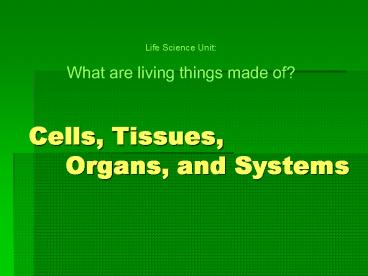Cells, Tissues, Organs, and Systems - PowerPoint PPT Presentation
Title:
Cells, Tissues, Organs, and Systems
Description:
Roots, stems, and leaves are organs of a plant. A leaf is an organ that makes food for the plant. The roots of a plant are the main organ in the root system of a plant. – PowerPoint PPT presentation
Number of Views:135
Avg rating:3.0/5.0
Title: Cells, Tissues, Organs, and Systems
1
Cells, Tissues, Organs, and Systems
Life Science Unit What are living things made of?
2
Living Things
- A living thing is an organism.
- Many organisms have a body with different parts.
- A structure is a body part that does a certain
job for an organism. - The function of a structure is the job it does
for the organism.
3
What are living things?
- Most living things share certain characteristics.
- They all have basic needs for food, water,
- a place to live, and oxygen.
- They are made up of cells, the building blocks
- of living things.
- They are made up of parts that have specific jobs
to help keep them alive.
4
Living things have 9 basic life functions
- Made of cells
- Reproduce (make more of their own kind)
- Grow and develop
- Has Genetic Code
- Evolve
- Use energy (they get energy by eating or making
food) - Get rid of waste
- Respond to the environment (Homeostasis)
5
Cells
- All organisms are made of cells.
- A cell is the smallest unit of living matter the
- basic unit of life.
- Some kinds of organisms, like bacteria, are
- made of only one cell.
- Other types of organisms, like people and trees,
- are made up of trillions of cells.
6
Many-Celled Organisms have different types of
cells
- Animals have
- Bone cells
- Nerve cells
- Muscle cells
- Blood cells
- Plants have
- Leaf Cells
- Root Cells
7
How are organisms organized? Many-celled
organisms are organized in cells, tissues,
organs, and organ systems. Cells
- Animals and plants are many-celled organisms.
- Animals are made up of many kinds of cells.
- You are made of blood cells, bone cells, skin
cells, and many others. - A plant also has different cells in its roots,
stems, and leaves.
8
Tissues
- In your body, a single skin cell or blood cell
does not work alone. - Cells work together in groups called tissues.
- A tissue is a group of similar cells that work
together carrying out a certain job. - For example, skin cells work together as skin
tissue that covers and protects your body. Other
kinds of tissue in an animals body include
muscle, bone, nerve and blood. - Plant cells are also organized into tissues.
- For example, leaves of plants are made of tissues
that help the plant make food.
9
(No Transcript)
10
OrgansThroughout your body, tissues are grouped
together so they can work together.
- An organ is a group of tissues that work together
doing certain jobs. - Roots, stems, and leaves are organs of a plant.
- A leaf is an organ that makes food for the plant.
- The roots of a plant are the main organ in the
root system of a plant. - The heart, lungs, and brain are examples of
animal organs. - Your heart is an organ
- It contains muscle tissue, nerve tissue, and
blood tissue. - Its job is to pump blood throughout your body.
11
Organ SystemsOrgan systems work together so life
processes like breathing and digestion can be
carried out, keeping many-celled organisms, like
you, healthy and alive.
- When a group of parts work together, they form a
system. - A group of organs working together to carry out a
specific life function is called an organ system. - A plants roots, stem, and leaves are an organ
system. - Your digestive system is an organ system
- It contains your mouth, esophagus, stomach, small
and large intestines, and liver. - Digestion breaks down food and absorbs nutrients
you need to live.
12
Cells, Tissues, Organs, and Systems
- A cell is the smallest unit of living matter the
building blocks of living things. - Tissues are groups of cells working together to
perform a certain job. - Organs are groups of tissues that perform a
certain function. - Organs working together to carry out a certain
life function are an organ system.
13
So why does Chemistry Matter?
- Chemical Level
- a. Atoms
- (Proton, Neutron, electrons)
- b. Molecules
- (Two or more atoms joined together by either
covalent or ionic bonds)
14
So why does Chemistry Matter?
- Four Biologically-Important Organic molecules
- b. Complex Carbohydrates
- made from simple sugars
- c. Nucleic Acids made for nucleotides
- d. Lipids made from fatty acids and glycerol
- 2. Cells
- (Smallest structural and functional units of
the human body)
15
Final Organization
- Atoms Molecules Organelles Cells Tissues
Organs Organ Systems - Organism































